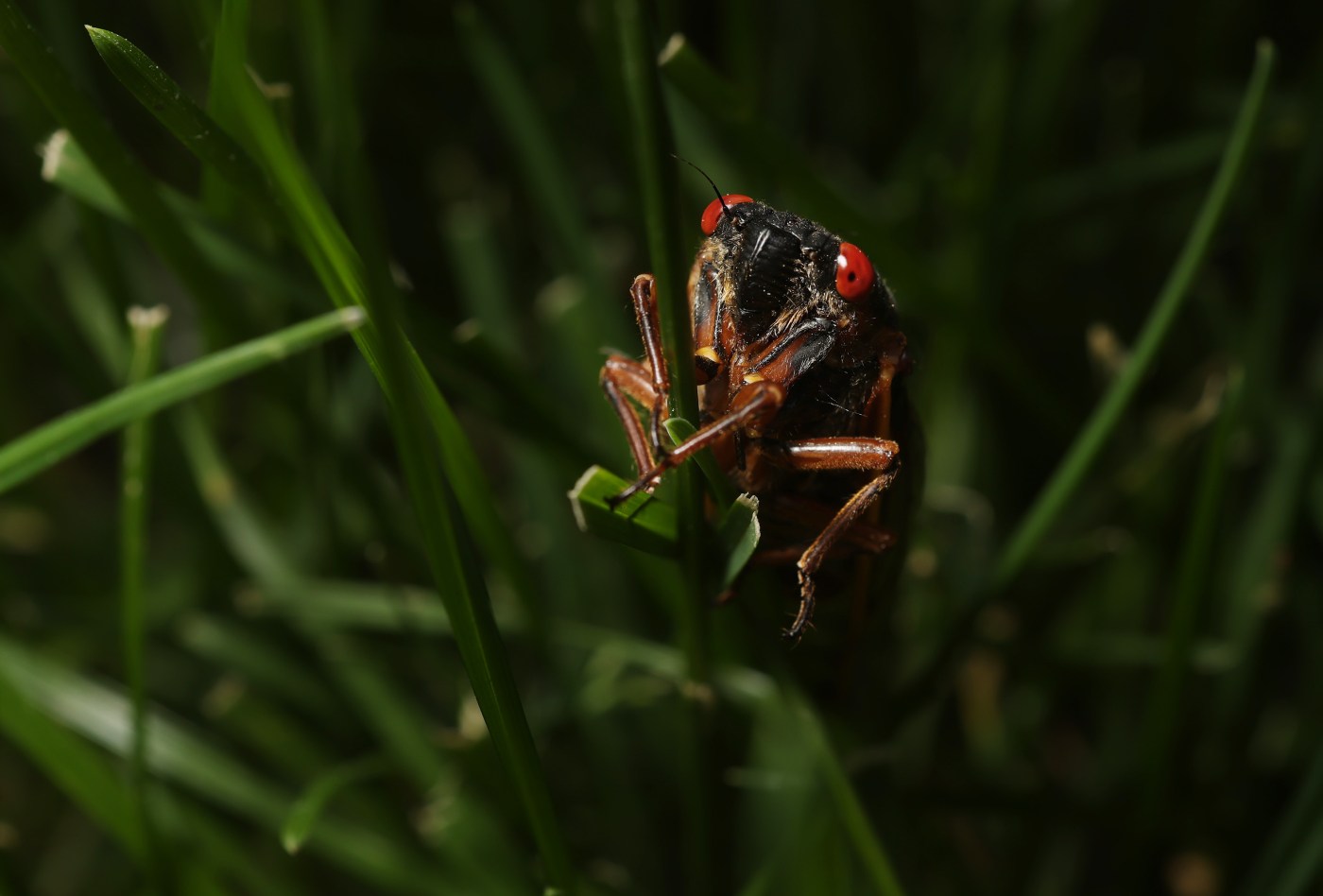
The bugs are coming! If a cicada invasion sounds familiar, thank Hollywood
Magicicada septendecim, also known as Brood XIII, also known as the 17-year locust, also known as the Northern Illinois Brood, also known as the cicada you’re most likely to squash (with malice or not) in the next few weeks, has burning red eyes. Large compound suckers. Looks perpetually alarmed. Its thorax is coal black. Its wings are veined and sort of orange-red, the color of plastic jack-o’-lanterns. Not to demonize these shuffling, jumpy critters. They won’t kill you. They won’t sting you. They won’t bite your head off. You actually could eat Magicicada septendecim. Aristotle ate cicadas. What, you think you’re better than Aristotle?
Brood XIII, though, is the perfect movie bug.
If this were a film, it would eat you: Some scientists in Springfield would be working on a way to solve world hunger, except good intentions would turn bad and Brood XIII would grow to the size of small dogs and develop a taste for human flesh. More likely, in the next few weeks, as Brood XIII spreads throughout Northeast Illinois, joining up in places with cousin Brood XIX, the worst that will happen is a bunch of dead trees and squirming human flesh.
Still, if you are like me, a connoisseur of bug films, the scenario is unnerving.
They don’t bite, they suck, draining precious bodily fluids (from trees). Their names alone — Brood XIII, The Great Southern Brood, and so forth — sound intentionally ominous, and their origin story — they rise out of the earth simultaneously once every 221 years, when the soil is at least 64 degrees — is basically off-brand Stephen King I.P. There are 2,500 species of cicada, and Illinois will see the ones straight out of central (bug) casting. As many as a trillion are expected, and while evolutionary biologists are not certain how cicadas know to rise out of the soil simultaneously, they suspect it’s partly a show of strength and pragmatism:
Should they emerge all at once, yes, many will perish — but mankind can’t stop them all.
The bug, any bug, as Hollywood has taught for generations, is an unknowable, unstoppable menace, autonomous and so rich in fecundity, it outpaces man’s ability to truly eradicate. In David Cronenberg’s still touching/disgusting 1986 remake of “The Fly,” Jeff Goldblum, in the late stages of his man-to-bug transformation, delivers a sort of movie bug manifesto. He feels the rush of the house fly growing inside him. He tells Geena Davis that “Insects don’t have politics.” Insects, he says, are brutal, they show “no compassion, no compromise — we can’t trust the insect.” It’s an explosion of freedom that people will never know. But right now, he does: “I am an insect who dreamt he was a man, and now that dream is over.”
What man has over bugs is size, but inevitably, that’s never enough, either.
In the meditative 1974 science fiction cult favorite “Phase IV” — the only film directed by Saul Bass, better known for merging graphic design with movie credit sequences in classics such as “Anatomy of a Murder” and “Psycho” — a scientist in the arid Southwest notes that his nemesis is “so defenseless in the individual, yet so powerful in mass.” He means lowly ants, which in the film, develop an ability to communicate across species and have begun to signal their intentions to man. Their messages are not inviting. The ants leave traps, take out computers, construct “2001”-like monoliths in the desert. Unlike in most bug thrillers, Bass dedicates an inordinate amount of time to watching actual bugs stalking, scurrying, forging. The point being, indeed, they look squishable. Yet there are so many of them, streaming outward in rivers of writhing ink-black malevolence, by the end of the film our hero (Michael Murphy) realizes he is being controlled by ants.
“We didn’t know for what purpose,” he says wistfully, “but we knew we would be told.”
More to the point, in the way-cheesier “Empire of the Ants” (1977), starring Joan Collins as a shady land developer, giant ants hole up in warehouse offices (seriously) and organize people (or at least Floridians) to do their bidding. “My god!” a woman shouts. “They’re herding us like cattle!” The movie bug — like the similar-sounding Borg of “Star Trek” — is a bundle of our uncanniest fears: Bugs are not individuals, bugs have patience, bugs self-sacrifice, bugs move in sync. They are the original hive mind. Like the real thing, movie bugs prove so uncomfortable to man, their verbs alone generate shivers: Bugs crawl, bugs creep, bugs nest, bugs chew, bugs cocoon. Bugs, if they’re doing their cinematic job, revolt. In “The Mist” (2007), Frank Darabont’s exceedingly nightmarish Stephen King adaptation, there’s a scene in which survivors of a giant bug invasion pick find victims pasted to the walls of a storage room, shrouded in webbing. A hand reaches out. A soldier, alive. Yet his skin pulses with nascent spiders. The soldier tumbles from the web and shatters into a puddle of bugs.
Bugs killed this man, we realize, but bugs were also holding him together.
Ew, sure. But I wouldn’t want it any other way.
I have been a lover of bug movies since my grandmother insisted on reminding me throughout my childhood that killer bees should be arriving from Mexico any day now. Gen X, back me up: Nukes were eventual, but killer bees were always just around the corner.
So, for a brief window in the 1970s, disaster movies merged with those newspaper warnings of coming insect plagues. As bad as the William Shatner vehicle “Kingdom of the Spiders” (1977) was, its images burrowed like termites: children (and their bikes) covered in webs, country roads littered with spiders. Rachel Carson didn’t predict in “Silent Spring” that William Shatner would one day hopscotch through streets of poisonous tarantulas, but “Kingdom of the Spiders” did raise real-world fears that pesticides could kill natural predators, creating imbalances in nature. “Squirm” (1976) promised a world in which extreme weather would lead (somehow) to everyday worms ganging up in carnivorous undulating spaghetti dinners that borrow into your face and make cicada-like cries of digital white noise sounding suspiciously like busted synthesizers.
The peak of this mini-trend was “The Swarm.” Its cast alone is proof that folks in the 1970s were sweating the threat of bug infestations: Henry Fonda plays a scientist, Olivia de Havilland plays a schoolteacher, Richard Chamberlain plays a doctor. Michael Caine, the hero, is shocked when killer bees invade Texas: “The bees have always been our friends!” But they derail trains, cause a nuclear explosion and completely raze Houston. (“Will history blame me or the bees?” asks the general, played by Richard Widmark.) The best part is the earnest disclaimer over the credits that plays now like a parody of environmentalism: “The African killer bee portrayed in this films bears absolutely no relationship to the industrious hard-working American honey bee to which we are indebted for pollinating vital crops that feed our nation.” I mean, the last thing Warner Bros. would need is picketing honey bees.
Especially after generations of mixed messaging.
If bug flicks since the 1970s have been largely concerned with unstoppable infestations of normal-size pests, Hollywood’s depiction of insects prior to Nixon and disco were defined by scale. In 1954, four months before “Godzilla” was initially released in Japan, launching the age of atomic monsters, “Them!” and its giant radioactive ants in the New Mexico desert scrambled there first. The opening scenes remain an effectively spooky template: A child is found wandering, only able to say “THEM!” A trailer is found demolished. A storekeeper is found dead, full of formic acid, a chemical generated by ants. What does it mean? A myrmecologist (Edmund Gwenn, who won an Oscar for playing Santa in “Miracle on 34th Street”) decides atomic testing at the nearby White Sands military base created big ants.
Giant bug movies of the 1950s played like “Frankenstein” smooshed against UFO invasion pictures with a heaping side of Cold War metaphor: Giant locusts (“Beginning of the End”) attack Chicago, a giant spider attacks Arizona (“Tarantula”), giant scorpions (“The Black Scorpion”) attack Mexico City. A few facts about the organized, devious nature of the invading hordes get muttered by scientists and generals, then invariably someone has to “call Washington.” Unless Washington is already threatened (“The Deadly Mantis”). Not unlike when politicians spoke of the Soviets, the predictions could get positively Biblical: “An entire population razed for deliverance!” screamed the trailer for “Black Scorpion.”
And the Bible doesn’t have a lot of good things to say about insects.
Most “are to be hated” (Leviticus 11:20). In fact, it’s a short walk from the Bible to the visceral nausea that characterizes the gnarliest use of bugs in movies. Kate Capshaw swings wildly at millions of bugs in “Indiana Jones and the Temple of Doom,” but it’s that single centipede that crawls into her hair that gets the audience gagging. One large spider crawls down the belly of a woman in the shower in “Arachnophobia.” There’s a bug scene in Peter Jackson’s remake of “King Kong” full of throbbing fanged pink worms but it’s the way the rescue party swats and spins and waves frantically at themselves that get across the ick.
Even as I write this, I itch.
But it’s hard to say precisely why. Bugs have become a shorthand for countless concerns, from mental collapse (“Bug,” William Friedkin’s 2006 adaptation of the Tracy Letts play), to feeling small (“A Bug’s Life“), to the dehumanization of the proletariat in probably the most celebrated bug story of all, Kafka’s “Metamorphosis.” But disgust is probably most common.
Nothing coveys revulsion faster than a wiggling dark clump of cockroaches. There’s nothing worse than walking into a cloud of gnats. Movie bugs play off this, like a psychosomatic extension of 3-D, causing physical recoil by merely being. Yet we hardly matter to them. As naturalist E.O. Wilson once wrote: “If all mankind were to disappear, the world would regenerate back to the rich state of equilibrium that existed ten thousand years ago. If insects were to vanish, the environment would collapse into chaos.” When cicadas — whose shrill whine sounds eerily like the evil ants of “Them!” — occupy our streets this summer, keep that mind. They do not want your flesh, and they do not want to herd you like cows.
But they will outlast you.
Step lively.
cborrelli@chicagotribune.com


